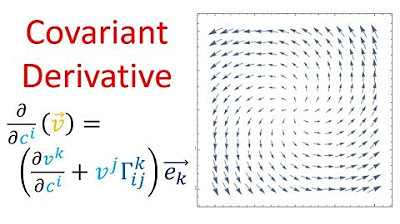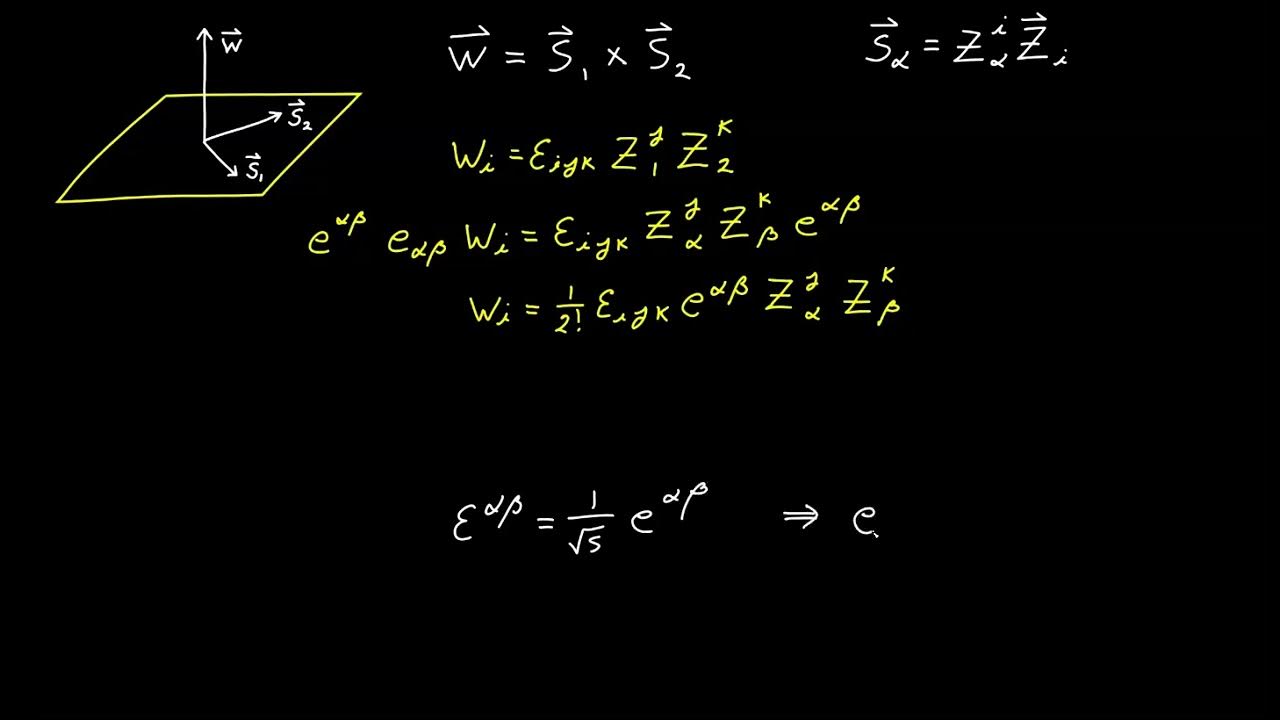Tensor Calculus 4: Derivatives are Vectors
TLDRThis video delves into the concept of vector fields along curves, contrasting them with individual vectors. It explains how to determine vector components in different bases, using the chain rule for multivariable calculus. The video provides a step-by-step guide on expanding vector fields into basis vectors, illustrating the process with a circular curve example in both Cartesian and polar coordinates. The Einstein summation notation is introduced for a more compact representation, highlighting the contravariant nature of vector field components.
Takeaways
- 📚 The video is an in-depth exploration of derivatives of vectors, building upon a previous video on vectors from the 'Tensors for Beginners' series.
- 🔍 It explains the process of expanding a vector V as a linear combination of basis vectors, both with an old and a new basis set.
- 📈 The concept of vector fields along a curve is introduced, where a vector is defined at every point along the curve, using tangent vectors.
- 🔑 The parameter lambda is used to represent the position vector R, acting similarly to time, with the derivative dR/dλ representing the tangent vector field.
- 📝 The video demonstrates how to calculate the tangent vector field using the limit of the difference vector divided by a small step h as h approaches zero.
- 🌐 The Cartesian coordinate system is used to measure the tangent vectors along the curve, with basis vectors being constant throughout space.
- 📊 The components of the vector field are found by expanding the derivative DR/dλ in Cartesian coordinates using the multivariable chain rule.
- 📚 The Einstein notation is introduced to express the basis vectors and components more compactly, showing the relationship between a vector, its basis, and its components.
- 🔄 The video provides an example of a circular curve, parameterized in both Cartesian and polar coordinates, to illustrate the process of finding vector field components.
- 📐 In the example, the components of the vector field in Cartesian coordinates are found to be -2sin(λ) and 2cos(λ), while in polar coordinates, they simplify to 0 and 1.
- 🔗 The takeaway emphasizes the similarity between expanding individual vectors and vector fields in different bases, highlighting that components change depending on the basis used.
Q & A
What is the main focus of the video?
-The video focuses on explaining the concept of vector fields along a curve, showing how to determine vector components in different bases, and how to use the chain rule to expand these vector fields in Cartesian and polar coordinates.
What is the prerequisite for understanding this video?
-The viewer should have watched the 'Tensors for Beginners' series, particularly the video on vectors, as this video builds upon that foundation.
How does the video define a vector field along a curve?
-A vector field along a curve is defined by assigning a vector at every point along the curve, which is obtained by looking at the tangent vectors to the curve.
What is the role of the parameter lambda in the context of curves?
-The parameter lambda is used to define the curve as a function that takes lambda as an input and outputs a position vector, similar to how time progresses in a motion scenario.
How is the tangent vector to a curve calculated?
-The tangent vector to a curve is calculated by taking the derivative of the position vector R with respect to the parameter lambda, denoted as dR/dλ.
What does the chain rule help achieve in the context of vector fields?
-The chain rule is used to expand the vector field dR/dλ in terms of the Cartesian coordinates, which allows us to express the vector field as a linear combination of basis vectors.
What are the components of a vector field in the context of the video?
-The components of a vector field are the derivatives dx/dλ and dy/dλ, which represent how much of the basis vectors ex and ey make up the vectors in the field.
How does the Einstein notation simplify the expression of vector fields?
-The Einstein notation allows for a more compact expression of vector fields by summing over indices, making it easier to represent basis vectors and their components.
What is an example of a curve used in the video to illustrate the concept of vector fields?
-The video uses a circular curve parameterized by x = 2cos(λ) and y = 2sin(λ) to demonstrate the concept of vector fields and their components.
How does the video explain the components of the vector field in polar coordinates?
-The video explains that the components of the vector field in polar coordinates are derived by converting the Cartesian parameterization of the curve to polar coordinates and then taking the derivatives with respect to lambda.
What is the significance of the contravariant nature of the components of vector fields mentioned at the end of the video?
-The contravariant nature of the components of vector fields indicates that they behave oppositely to how basis vectors behave, which is an important concept for understanding how vector fields transform under coordinate changes.
Outlines
📚 Introduction to Vector Fields and Basis Vectors
This paragraph introduces the concept of vector fields along a curve, building upon the basics of vectors and basis vectors from a previous tutorial. The video aims to explore how to determine vector components in different bases, transitioning from individual vectors to vector fields. The process involves expanding a vector in terms of basis vectors and then applying the same principle to vector fields, specifically those along a curve. The tangent vectors to a curve are highlighted as the means to create a vector field, with the curve defined as a function of an input parameter lambda. The tangent vector at any point on the curve is found by differentiating the position vector with respect to lambda. The paragraph concludes with the idea of using the Cartesian coordinate system's basis vectors to measure the tangent vectors along the curve.
🔍 Deriving Components of Vector Fields Using Chain Rule
This paragraph delves into the specifics of calculating the components of a vector field along a curve using the chain rule from multivariable calculus. It explains how to express the derivative of a position vector with respect to the parameter lambda as a linear combination of the Cartesian basis vectors. The components of the vector field are identified as the derivatives of the position vector's x and y components with respect to lambda. The paragraph also introduces Einstein notation to express the basis vectors and components more compactly. An example of a circular curve is provided to illustrate the process, showing how the tangent vector field's components can be determined in the Cartesian coordinate system.
🌐 Exploring Vector Fields in Polar Coordinates
This paragraph extends the discussion to vector fields in polar coordinates, demonstrating how to convert a given curve from Cartesian to polar coordinates and then calculate the components of the vector field in this new coordinate system. The example of a circle is revisited, showing the conversion of its parameterization to polar coordinates and the simplification of the vector field components to 0 and 1, respectively. The significance of these components is explained in the context of the polar coordinate system, highlighting the constant radius and angular movement around the origin. The paragraph reinforces the idea that the components of a vector field can vary depending on the coordinate system used, paralleling the behavior of ordinary vectors when expanded in different bases.
🔗 Connecting Vectors and Vector Fields Across Coordinate Systems
The final paragraph synthesizes the concepts discussed throughout the script, emphasizing the similarity between handling individual vectors and vector fields when it comes to basis expansion and component determination. It reiterates the use of the chain rule and Einstein notation for expressing vector fields in various coordinate systems. The paragraph concludes by previewing the next video's content, which will explore the contravariant nature of vector field components, hinting at their behavior in relation to basis vectors.
Mindmap
Keywords
💡Derivatives
💡Vectors
💡Basis Vectors
💡Vector Fields
💡Curves
💡Parameterization
💡Tangent Vectors
💡Chain Rule
💡Einstein Notation
💡Polar Coordinates
💡Contravariant Components
Highlights
Introduction to the concept of vector fields along a curve, which is an extension of the basic vector concept.
Explanation of how to expand a vector as a linear combination of basis vectors in both old and new bases.
Demonstration of the process of determining vector components in a basis for vector fields.
Introduction of the tangent vector field derived from curves and its significance in space.
Description of a curve as a function of an input parameter lambda, relating it to the concept of time.
Calculation of the tangent vector to a curve using the derivative of position vector R with respect to lambda.
Illustration of the multivariable chain rule for expanding a vector field in Cartesian coordinates.
Clarification of the components of a vector field as derivatives with respect to the basis vectors.
Introduction of Einstein notation for a more compact expression of basis vectors and components.
Comparison between expanding a single vector and a vector field in terms of basis vectors and components.
Example of a circular curve and its parameterization in Cartesian coordinates.
Derivation of the vector field components for the circular curve using the chain rule.
Verification of the vector field components at specific points on the curve.
Transition to polar coordinates for a different perspective on the vector field.
Conversion of the circular curve parameterization to polar coordinates for further analysis.
Derivation of the vector field components in polar coordinates and their simplicity.
Final takeaway emphasizing the similarity between handling individual vectors and vector fields along a curve.
Introduction of the concept of contravariance in the components of vector fields.
Transcripts
5.0 / 5 (0 votes)
Thanks for rating:





